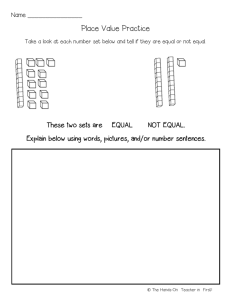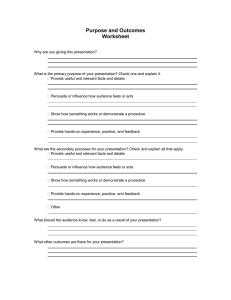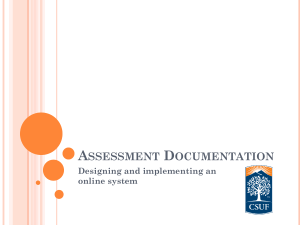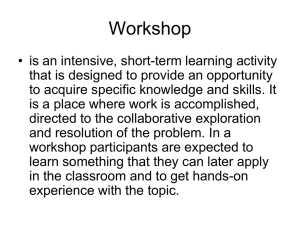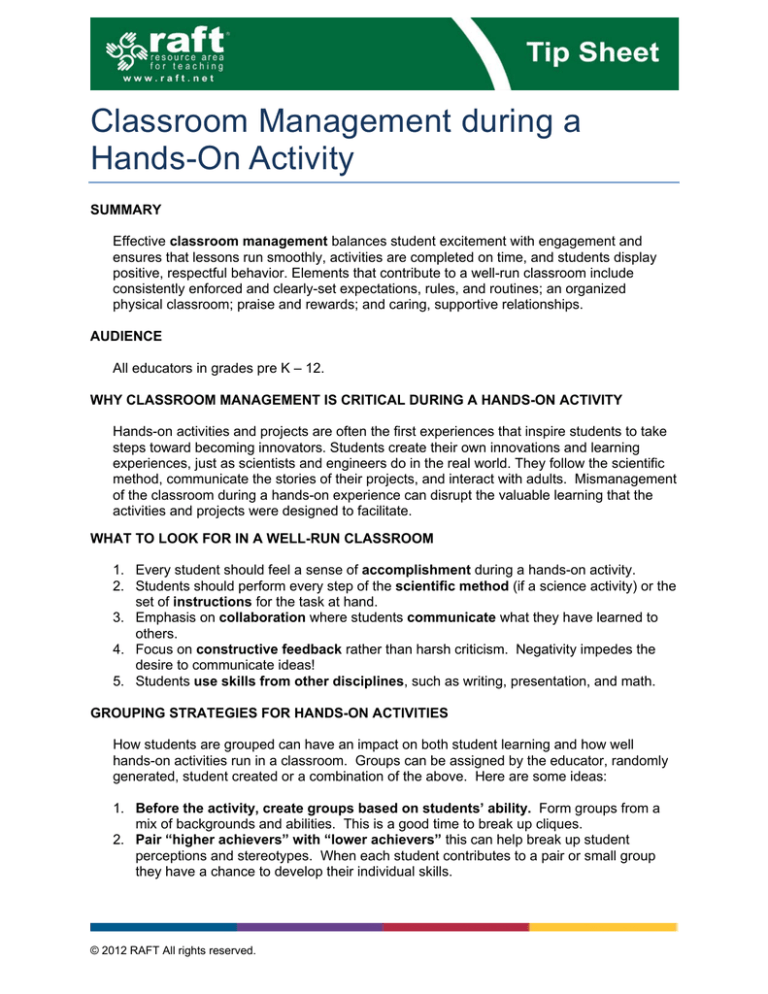
Classroom Management during a
Hands-On Activity
SUMMARY
Effective classroom management balances student excitement with engagement and
ensures that lessons run smoothly, activities are completed on time, and students display
positive, respectful behavior. Elements that contribute to a well-run classroom include
consistently enforced and clearly-set expectations, rules, and routines; an organized
physical classroom; praise and rewards; and caring, supportive relationships.
AUDIENCE
All educators in grades pre K – 12.
WHY CLASSROOM MANAGEMENT IS CRITICAL DURING A HANDS-ON ACTIVITY
Hands-on activities and projects are often the first experiences that inspire students to take
steps toward becoming innovators. Students create their own innovations and learning
experiences, just as scientists and engineers do in the real world. They follow the scientific
method, communicate the stories of their projects, and interact with adults. Mismanagement
of the classroom during a hands-on experience can disrupt the valuable learning that the
activities and projects were designed to facilitate.
WHAT TO LOOK FOR IN A WELL-RUN CLASSROOM
1. Every student should feel a sense of accomplishment during a hands-on activity.
2. Students should perform every step of the scientific method (if a science activity) or the
set of instructions for the task at hand.
3. Emphasis on collaboration where students communicate what they have learned to
others.
4. Focus on constructive feedback rather than harsh criticism. Negativity impedes the
desire to communicate ideas!
5. Students use skills from other disciplines, such as writing, presentation, and math.
GROUPING STRATEGIES FOR HANDS-ON ACTIVITIES
How students are grouped can have an impact on both student learning and how well
hands-on activities run in a classroom. Groups can be assigned by the educator, randomly
generated, student created or a combination of the above. Here are some ideas:
1. Before the activity, create groups based on students’ ability. Form groups from a
mix of backgrounds and abilities. This is a good time to break up cliques.
2. Pair “higher achievers” with “lower achievers” this can help break up student
perceptions and stereotypes. When each student contributes to a pair or small group
they have a chance to develop their individual skills.
© 2012 RAFT All rights reserved. 3. Randomize groups to mix students. Have students count off, draw a card, or roll a
die and group students by common number or suit.
4. Choose team captains based on student experience and abilities – find ways to foster
leadership in a many different students over time.
GUIDED REFLECTION
1. Look back – Ask the students what worked during this activity or project?
2. Look forward – ask them to reflect on what skills they practiced and what concepts
they learned. How can they use those skills and concepts in the future?
ASSESSMENT
1. Look for evidence of engagement and learning. Are the students actively working on
the activity? Are students grasping the key underlying concepts?
2. After the activity or project – listen to the students’ reflections. Are students seeing
themselves as team players and creative problem-solvers?
RELATED RESOURCES
RAFT has many “done-in-a-day” hands-on activities that are low maintenance in terms of
classroom management:
‐ http://www.raft.net/ideas/Colors of Light.pdf
‐ http://www.raft.net/ideas/Finger-Phone.pdf
‐
Classroom management ideas from other experienced teachers:
http://www.brighthubeducation.com/classroom-management/3318-top-5-strategies-fromveteran-teacher/
© 2012 RAFT All rights reserved.

